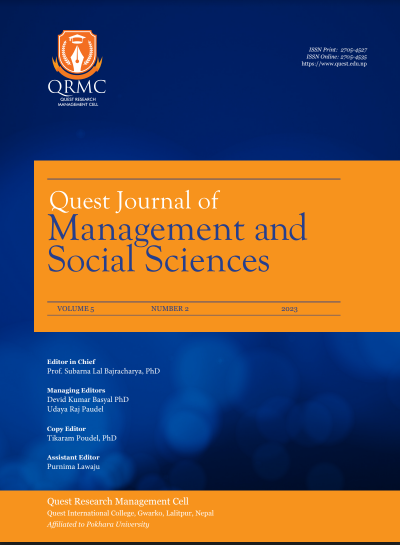Economic Growth, Public Expenditure, and Infrastructure on Provincial Financial Development of Nepal
DOI:
https://doi.org/10.3126/qjmss.v5i2.60928Keywords:
Economic growth, public expenditure, infrastructure, financial development, fixed effect modelAbstract
Purpose: Financial development is inevitable to finance the domestic resources in the development of Nepal at the provincial level. This paper intends to evaluate the nexus of financial development at the provincial level with economic growth, public expenditure, and infrastructure.
Design/Methodology/Approach: The targeted variables––financial development is a proxy by branches of banks and financial institutions and other regressors––economic growth (a proxy by annual growth in gross domestic product), public expenditure (proxied by current and capital expenditure), infrastructure (proxied by road networks, number of schools, electricity production) are considered throughout 2019 to 2023 across the seven provinces of Nepal. A fixed effect panel data model (FEM) is taken to estimate the intended outcome. To check the heteroscedasticity, autocorrelation, and cross-sectional dependency (CD), the CD test and Panel-Corrected Standard Errors (PCSE) are regressions that are also performed.
Findings: The stylised facts, as a whole, indicate that the growth nexus has had a negative impact. However, infrastructure exerts a more significant influence on the financial development of Nepal's provinces. Additionally, combined public spending that is neither capital nor current has helped advance financial development in the provinces.
Value/Originality: The results of the study highlight the necessity of prioritising infrastructure improvements and effective combined public spending to support financial development in Nepal's provinces. It offers unique insights not previously explored in Nepalese academia. Updated and relevant data are collected and applied to the different channels to evaluate the nexus of financial development at the province level of Nepal.
Recommendation: Policymakers should give due consideration to the effective mobilisation of fiscal resources with proper fiscal discipline in every aspect. Moreover, enhancing the allocation of development finance has the potential to stimulate financial development across all areas herein examined.
Keywords: Economic growth, public expenditure, infrastructure, financial development, fixed effect model
JEL classification: H54, H72, G21, O47, C33
Downloads
Downloads
Published
How to Cite
Issue
Section
License
Copyright (c) 2023 Quest Journal of Management and Social Sciences

This work is licensed under a Creative Commons Attribution-NonCommercial-NoDerivatives 4.0 International License.
This license enables reusers to copy and distribute the material in any medium or format in unadapted form only, for noncommercial purposes only, and only so long as attribution is given to the creator.




